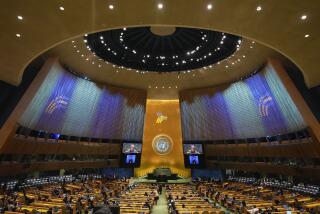The Treaty Meant to Unite
- Share via
President Mikhail S. Gorbachev was to prepare for the signing of a Union Treaty to hold the Soviet Union together. A look at the treaty and the issues it raises:
GOALS: Strengthens powers of the republics, giving more control over finances and natural resources. It also augments the powers of the lower house of the national legislature, which includes representatives of the republics. The treaty would change the name of the country from the Union of Soviet Socialist Republics to the Union of Sovereign Soviet Republics.
GORBACHEV’S ROLE: Gorbachev had been working on the treaty for four months. It is his major domestic political achievement this summer and was designed to head off criticism that his reforms had caused disintegration of the union.
WHO WAS TO SIGN: The leaders of at least three of the 15 republics, the Russian Federation, Kazakhstan and Uzbekistan, had been expected to sign the Union Treaty today, with other republics free to sign at any time. Byelorussia, Azerbaijan,
Kirgizia, Turkmenistan and Tadzhikistan are likely to sign later. The Ukraine and Armenia may sign.
OBJECTIONS: Georgia, Moldova and the Baltic republics of Lithuania, Latvia and Estonia want full independence and have said they will not sign. Russian Federation President Boris N. Yeltsin criticized the part of the treaty dealing with taxes. The treaty allows the republics to collect taxes but exacts a contribution to the national budget according to “fixed percentages” to be worked out.
THOSE WHO DON’T SIGN: The Baltics’ refusal to sign would leave the new union without its most European region and with a possible majority of mainly Muslim republics. The giant Russian Federation would remain the union’s dominant power. It remains unclear what status the independence-seeking republics would have.
More to Read
Sign up for Essential California
The most important California stories and recommendations in your inbox every morning.
You may occasionally receive promotional content from the Los Angeles Times.












